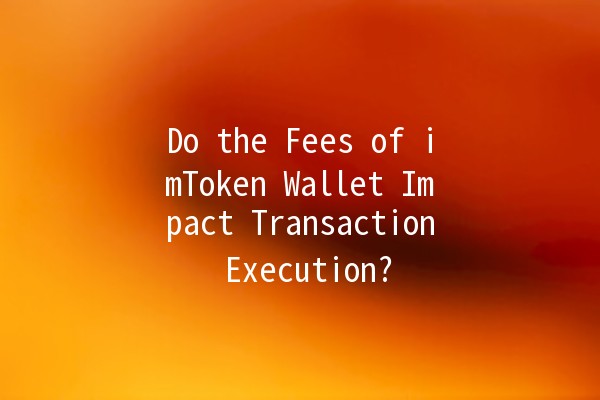In the rapidly evolving landscape of cryptocurrency, understanding how wallet fees affect transaction execution is crucial for both novice and experienced users alike. imToken, a leading digital asset wallet, allows users to manage their cryptocurrencies effectively. However, like many wallets, it involves transaction fees that can influence the overall user experience when executing transactions. This article delves into the intricacies of imToken wallet fees, their implications for transaction execution, and offers practical tips for users aiming to optimize their trading experience.
Wallet fees are charges that users may incur when sending or receiving cryptocurrency through a digital wallet. These fees typically cover transaction processing costs on the blockchain network used by the wallet. In the case of imToken, fees are related to the Ethereum network and various other blockchains supported by the wallet.

One of the most significant impacts of wallet fees is on the speed of transaction execution. When sending cryptocurrency, users can often choose their transaction fee. In busy networks, opting for a higher fee typically results in faster processing; conversely, choosing a lower fee may lead to delays in transaction confirmation.
For example, during peak times on the Ethereum network, users attempting to send ETH with a low network fee might find their transactions placed on hold until network congestion decreases. As a result, users eager to trade or transfer funds must carefully consider the associated fees to ensure timely execution.
When deciding on the fee to pay, users face a tradeoff between cost and urgency. Understanding the current state of the network can help users make more informed decisions. If a user needs to complete a transaction quickly, they might select a higher fee, while those who are willing to wait may opt for a lower fee.
Certain events, such as the launch of new cryptocurrencies or a major exchange listing, can lead to spikes in network activity. Users planning to transact during these times should prepare for increased fees and potential execution delays.
For timesensitive transactions (such as trading on exchanges that may offer limitedtime promotions), it's advisable to select a higher fee tier to ensure prompt execution.
Regularly review your transaction needs and adjust strategies accordingly. If you're consistently sending lowvalue transactions, consider alternatives, such as accumulating assets for larger transactions that may minimize fees.
Wallet fees, particularly network fees, can change frequently based on blockchain congestion. Regularly monitoring fee trends can help users plan their transactions more effectively.
Yes, imToken allows users to customize their transaction fees based on urgency. Users can select a fee that aligns with their needs.
Setting a low fee may result in delayed transaction processing. If network congestion is high, transactions with lower fees can be deprioritized, leading to longer confirmation times.
Avoiding fees entirely can be challenging, as most blockchain operations incur some cost. To minimize fees, users can consider consolidating transactions or transacting during offpeak hours.
No, withdrawal fees vary for different cryptocurrencies and are updated regularly based on network conditions and asset types.
Users can view transaction history within the imToken wallet, which provides details about past transactions, including fees paid.
The imToken wallet offers users an efficient platform for managing and transacting cryptocurrencies. However, understanding the nuances of wallet fees is crucial for optimal transaction execution. By monitoring network conditions, adjusting transaction strategies based on urgency, and making use of available tools, users can enhance their trading experience on imToken. Balancing cost against the need for speed is vital for successful cryptocurrency transactions, and adopting best practices will serve longterm user interests in the everevolving crypto landscape.